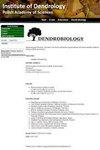间伐对突尼斯西北部松松发育和土壤理化特征的影响:间伐强度下径向生长的模拟
IF 1.8
4区 农林科学
Q2 FORESTRY
引用次数: 4
摘要
在本研究中,还研究了疏伐强度对林分行为和土壤性质的潜在有益影响。本研究旨在验证这样一种假设,即在幼时疏伐到不同的林分密度可以提高松树林分的木材、球果的生产力和土壤的物理化学特性。我们的研究基于四种间伐强度(30%、40%、50%和65%)与对照图的比较。该研究补充了四种间伐强度下树木径向生长的特征。它是基于1994年在突尼斯塔巴尔卡森林安装的一个完整的随机实验场。对于径向生长分析,从125棵树上取三个岩芯,每个地块取一棵树。研究表明,疏伐对所有树木测量参数都有显著影响。他们发现,与其他疏伐和对照地块相比,65%的疏伐强度产生了最好的木材产量(180.710 m3/ha)、年产量增长(4.634 m3/ha/年)和锥形产量(1211个锥形/公顷)。相关植被也受到疏伐强度的影响。与对照相比,疏伐处理改善了土壤的理化特性。与对照组(1.1至2毫米/年)相比,记录到显著的径向生长稀疏,尤其是在稀疏强度为65%(增加3.5至6.1毫米/年的情况下)。在第4次疏伐中记录到径向生长与年龄之间的密切关系(R2=0.923)。鉴于小齿轮松在世界市场上的重要性,这些结果可作为改进小齿轮松造林的初步基础,以提高突尼斯木材,尤其是球果的林分生产力。本文章由计算机程序翻译,如有差异,请以英文原文为准。
Effect of thinning on Pinus pinea L. development and physico-chemical soil characteristics in northwestern Tunisia: modeling of radial growth under thinning intensity
In this study, the potential beneficial impacts that the thinnings intensity on stand behavior and soil properties are also studied. This study was designed to test the hypothesis that thinning to various stand densities at young age enhance productivity of wood, cones and the physicochemical characteristics of the soil in Pinus pinea stands. We based our study on four thinning intensity (30, 40, 50 and 65%) in comparison with the control plot. The study was supplemented by a haracterization of radial growth of trees under the four thinning intensity. It was based on a complete randomized experimental field installed in 1994 in Tabarka forest, in Tunisia. For the radial growth analysis, three cores were taken from 125 trees at a rate of one tree per plot.The study showed that thinning has a significant effect on all dendrometric parameters. They revealed that a thinning intensity of 65% produces the best wood production (180.710 m3/ha), in annual growth in volume (4.634 m3/ha/year) and cone production (1211 cones/ha) compared to other thinning and control plot. Associated vegetation was also influenced by thinning intensities. The physicochemical characteristics of the soil were improved by thinning compared with the control. Significant radial growth thinning was recorde especially in a thinning of 65% intensity (increases of 3.5 to 6.1 mm/year) compared to the control (1.1 to 2 mm/year). A strong relationship between radial growth and age was recorded at Thinning 4 (R2 = 0.923). These results can be used as an initial basis to refine silviculture of pinion pine in order to improve stand productivity in Tunisia in wood and especially in cones given their importance on the world market.
求助全文
通过发布文献求助,成功后即可免费获取论文全文。
去求助
来源期刊

Dendrobiology
农林科学-林学
CiteScore
2.20
自引率
11.10%
发文量
17
审稿时长
>12 weeks
期刊介绍:
Dendrobiology publishes original research articles and review articles related to the biology of trees and shrubs.
 求助内容:
求助内容: 应助结果提醒方式:
应助结果提醒方式:


